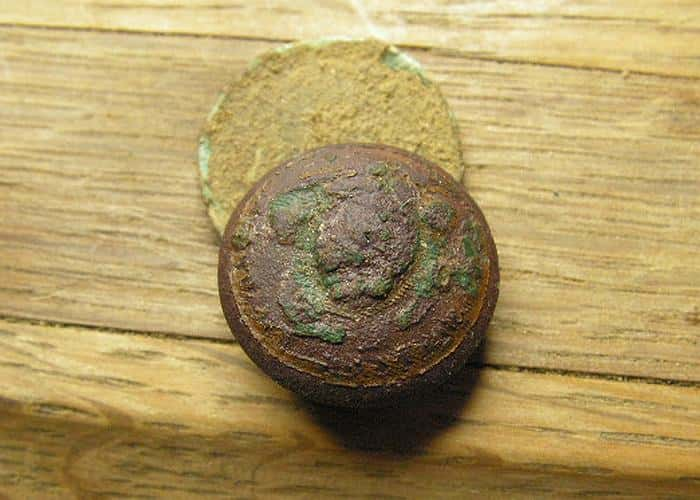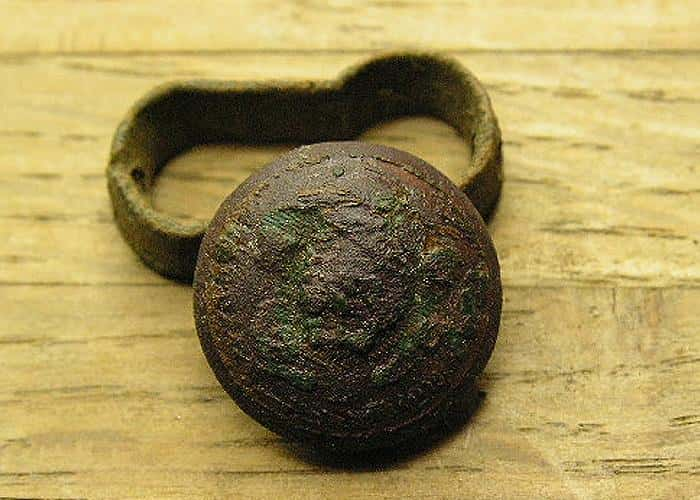Another Rare Civil War, Confederate Uniform Button
02/21/16
 <p><strong>I have been very fortunate in finding some elusive Confederate Military Uniform buttons since I started detecting in NC, and this one is no exception to rarity dug with the amazing GPX 5000, around 13 plus inches deep in heavy red clay!</strong> Forget about all the shiny gilt that dressed this button at one time, sadly it's long gone now. It has succumbed to the elements. Hard to see from the photos, but it is indeed listed as 13mm {Albert's SU 272} The design Features a "Don't mess with me" Hornets nest Cool with "NC" on sides on a lined field, and "MILITARY INSTITUTE" around the edge. Some Cadets manned an artillery piece in the Civil War's FIRST land battle at Big Bethel, Virginia in June 1861.</p>
[split]
<p>The North Carolina Military Institute was organized in the 1850s by a group of Charlotte businessmen led by Dr. Charles J. Fox. The cornerstone of the first building was laid in 1858. The building and educational programs it housed were patterned after those of the United States Military Academy at West Point.</p>
<p>D. H. Hill, previously a professor at Davidson College, directed the development of the curriculum and served as chairman of the board of directors. Hill established strict rules of conduct for his cadets based on training he received as a student at West Point and his experiences in the Mexican War. After receiving his charter in 1859, the Institute enrolled approximately 125 students ranging in age from twelve to twenty-one. The first class of cadets graduated in 1860 and served as one of the first recruits and personal training for troops of North Carolina at the very beginning of the Civil War.</p>
<p>Then , at the beginning of the American Civil War, Governor Zebulon B. Vance called DH Hill and other military strategists to Raleigh to mount camps of instruction for newly recruited troops. Hill was placed in command of Camp Ellis in Raleigh and was accompanied by many of his faculty and his cadets to form the First Regiment of North Carolina. All of the staff of the regiment were former faculty members of the Institute. When the regiment was formed, the Assistant General Robert F. Hoke stipulated that the cadets could join the regiment with the permission of their parents and guardians. Once most students and all members of the leadership of the faculty had gone to war, the school was used as a Confederate military hospital.</p>
<p><strong>I have been very fortunate in finding some elusive Confederate Military Uniform buttons since I started detecting in NC, and this one is no exception to rarity dug with the amazing GPX 5000, around 13 plus inches deep in heavy red clay!</strong> Forget about all the shiny gilt that dressed this button at one time, sadly it's long gone now. It has succumbed to the elements. Hard to see from the photos, but it is indeed listed as 13mm {Albert's SU 272} The design Features a "Don't mess with me" Hornets nest Cool with "NC" on sides on a lined field, and "MILITARY INSTITUTE" around the edge. Some Cadets manned an artillery piece in the Civil War's FIRST land battle at Big Bethel, Virginia in June 1861.</p>
[split]
<p>The North Carolina Military Institute was organized in the 1850s by a group of Charlotte businessmen led by Dr. Charles J. Fox. The cornerstone of the first building was laid in 1858. The building and educational programs it housed were patterned after those of the United States Military Academy at West Point.</p>
<p>D. H. Hill, previously a professor at Davidson College, directed the development of the curriculum and served as chairman of the board of directors. Hill established strict rules of conduct for his cadets based on training he received as a student at West Point and his experiences in the Mexican War. After receiving his charter in 1859, the Institute enrolled approximately 125 students ranging in age from twelve to twenty-one. The first class of cadets graduated in 1860 and served as one of the first recruits and personal training for troops of North Carolina at the very beginning of the Civil War.</p>
<p>Then , at the beginning of the American Civil War, Governor Zebulon B. Vance called DH Hill and other military strategists to Raleigh to mount camps of instruction for newly recruited troops. Hill was placed in command of Camp Ellis in Raleigh and was accompanied by many of his faculty and his cadets to form the First Regiment of North Carolina. All of the staff of the regiment were former faculty members of the Institute. When the regiment was formed, the Assistant General Robert F. Hoke stipulated that the cadets could join the regiment with the permission of their parents and guardians. Once most students and all members of the leadership of the faculty had gone to war, the school was used as a Confederate military hospital.</p>


